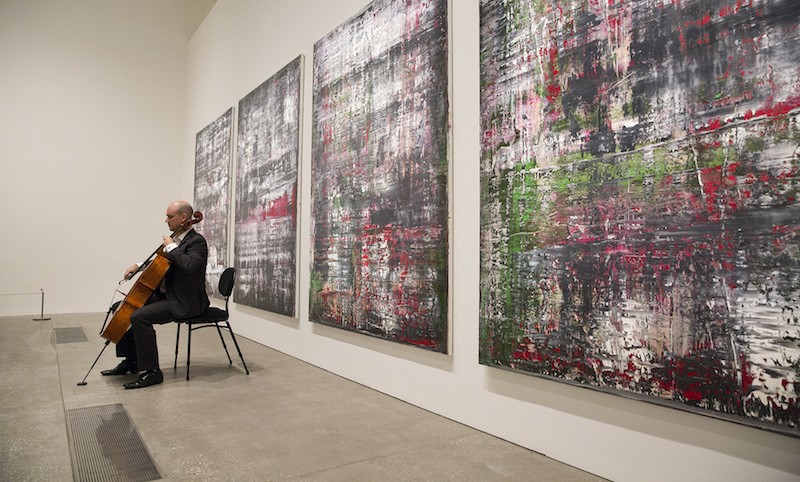GOMA, Brisbane
February 3, 2018
Inspired by GOMA’s Gerhard Richter exhibition, Reprise, curated by Opera Queensland’s new Artistic Director Patrick Nolan, was a contemplative exploration of art song inspired by Richter’s eclectic expression of art.
The GOMA setting, with a stage tucked into an acoustically blessed corner, created an appropriate intimacy for this beautifully delivered recital, that functioned as a tribute to the German artist. The aim was to create a convincing resonance with the Richter exhibits, and the audience was invited to view the exhibition before and after the recital. As a bonus, it celebrated the underrated storytelling charm of song, that in this recital, crossed classical and jazz borders.
 Reprise. Photo © Stephanie Do Rozario
Reprise. Photo © Stephanie Do Rozario
Just as Richter’s painting Emma is a photographic image re-imagined in paint, Beethoven wrote different versions of An Die Hoffnung and offered alternative sonic perspectives of the same material. Reworking existing musical themes, as Richter reinvents photographic images, is an established practice in classical music.
Tenor Brenton Spiteri convincingly channeled a varied palette of German song. His interpretative flair effectively and authentically recreated the compositional language of Beethoven, Richard Strauss and Henze. His vocal colour, texture and tone changed for each composer’s lexicon and he seamlessly scaled the transitions between the extreme registers in Henze’s fiendishly difficult Sechs Gesange aus dem Arabischen.
Pianist Alex Raineri deserves credit for performing as an associate artist rather than an old-school shrinking violet accompanist. He has a keen ear for shifting harmonic colours and provided lovely cushioned support for Spiteri’s full-blooded singing. As a voyager of the keys, Raineri is courageous. He doesn’t shy away from risk in his drive towards dramatic moments. He and Spiteri were admirably dovetailed, sailing the peaks and plateaus of a phrase impressively in sync.
Disappointingly, selections from Bach’s Six Cello Suites were not performed. A pity, since this would have contributed a contrasting instrumental voice. Cellist Nathan Smith’s golden-toned contribution to Strauss’ Morgen Op. 27 No 4 was a plus.
But why wasn’t John Cage on the program? After all, Cage sliced open, dissected, challenged, dissolved boundaries and expanded classical music’s traditions and blew to smithereens notions of what music is. He was a contemporary of Richter’s and a parallel revolutionary.
Enjoyable though the above performances were, The Richter Songs’ pluralistic ideas had a greater resonance and relevance. Composed and performed by Paul Grabowsky, The Richter Songs was a specially commissioned work.
“If I could, I’d paint your heart, Crimson and Vermilion, all the Sins and all the billion beats” sang distinctive Melbourne artist Gian Slater in Clean White Walls.
The Richter Songs was the most intriguing work because Megan Washington’s reflective lyrics and Grabowsky’s mellow, marbled, misty and rhythmically flexing music corresponded directly to three of the artist’s works: Ella, Memento Mori and Clean White Walls. With an illustration of the above works and the lyrics printed in the program, this performance connected the audience most directly to Richter’s art. Like last year’s Sensory, an equivalent multi-arts presentation, Reprise was an entertaining close encounter of a cultural kind.
EDIT
Nathan Smith did indeed perform the Cello Suites within the Gerhard Richter exhibition – this occurred before the other performances.











Comments
Log in to join the conversation.